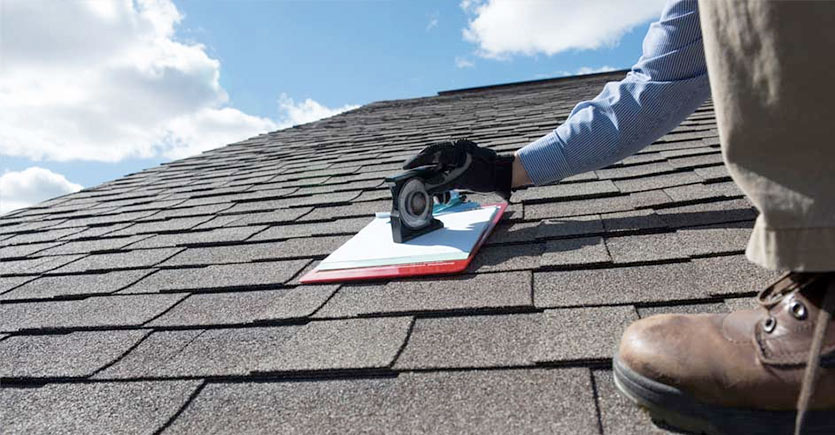Just How to Evaluate Different Roof Alternatives for Your Structure Needs
Reviewing roofing alternatives for your building calls for a detailed approach that considers various variables such as the intended usage of the structure, neighborhood environment conditions, and material characteristics - Roofer. It is vital to consider the advantages and drawbacks of different roof covering types, from asphalt tiles to metal and clay floor tiles, while likewise factoring in first costs and lasting maintenance.
Evaluating Your Structure's Demands
To successfully assess roof covering options, start by completely evaluating your building's needs. Start by considering the structure's planned use, as various structures may necessitate varying roof covering specifications. Domestic roofs frequently focus on appearances and insulation, while commercial buildings may focus on durability and load-bearing capacity.
Following, examine the regional climate problems that will certainly impact roofing performance. Variables such as temperature variations, rainfall degrees, and wind patterns can influence product selection and layout. A roofing system that masters a warm climate might not carry out as well in locations susceptible to heavy snowfall or extreme warmth.
Furthermore, evaluate the structural integrity of your structure. Make sure that the existing structure can support the picked roof covering materials, especially if considering much heavier options. It is additionally critical to examine any neighborhood building regulations or regulations that might dictate particular demands for roof.

Comparing Roof Products
As soon as an extensive evaluation of your building's requirements has been finished, the next step entails contrasting various roof covering products. Each material provides distinctive advantages and disadvantages, making it important to straighten your selection with your specific needs and conditions.
Asphalt tiles are commonly recognized for their cost and simplicity of installation, making them a prominent choice for residential structures. On the other hand, metal roofing, known for its toughness and longevity, can stand up to harsh weather yet might include a higher preliminary financial investment.
Clay and concrete floor tiles offer exceptional thermal insulation and aesthetic charm, particularly for Mediterranean-style architecture, yet they call for an even more robust structural assistance because of their weight. Wood shakes offer a natural appearance and excellent insulation residential properties but may demand a lot more maintenance and are vulnerable to fire dangers.
Evaluating Expense and Budget
Evaluating your roofing options requires a careful analysis of cost and budget plan factors to consider. The general allocate a roof covering job consists of several factors, including product costs, labor expenses, maintenance, and possible long-lasting financial savings. It is necessary to establish a clear spending plan before checking out specific roof covering products, as this will lead the decision-making process and assist you avoid overspending.
Begin by getting site quotes from multiple service providers to understand labor costs in your region. Guarantee that these price quotes include all essential solutions, such as removal of the old roofing system, installment, and any extra features, like insulation or ventilation enhancements - Roofing Contractor. Next off, assess the price of different roof covering materials, thinking about both preliminary installation expenses and anticipated life-span

Comprehending Power Performance
Power efficiency plays a vital duty in the selection of roof materials and systems, substantially impacting both power usage and total comfort within a building. An appropriate roof covering can boost thermal efficiency, reducing the demand for home article heating and cooling down systems, which in turn lowers energy bills and reduces environmental influence.
When assessing roofing choices, consider materials that show instead than absorb warmth. Furthermore, proper insulation and ventilation are essential to optimize the energy effectiveness of the whole roof system.
One more vital factor is the roofing system's long life and maintenance requirements. Durable materials that call for less constant replacement add to long-lasting energy financial savings. The power effectiveness of a roof covering system can additionally be analyzed with its compliance with well-known sustainability rankings such as ENERGY CELEBRITY or LEED.
Considering Aesthetic Appeal
A roofing's aesthetic charm substantially affects the overall appearance of a structure, matching its architectural style and discover here enhancing visual charm. Roofer. When evaluating roof alternatives, it is vital to consider exactly how the selected product, color, and layout will integrate with the existing structure and area. A well-designed roof can elevate even the easiest of buildings, transforming them right into visual prime focus
Various roofing products use numerous aesthetic high qualities. Conventional shingles may evoke a traditional charm, while steel roofing can give a modern, streamlined appearance. In addition, the color of the roof covering product plays a crucial duty; lighter tones can make a structure show up even more spacious, while darker tones may develop a cozier atmosphere.
Moreover, building components, such as dormers and eaves, can improve the roofing system's aesthetic effect. It is recommended to speak with expert designers or engineers to guarantee the selected roof alternative lines up with the total design intent. Inevitably, a roofing system ought to not just provide functional advantages however also add favorably to the building's aesthetic, showing the proprietor's taste and the personality of the surrounding atmosphere.
Conclusion
